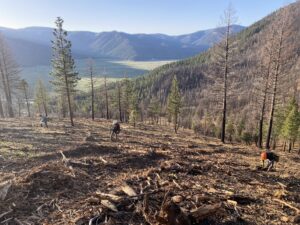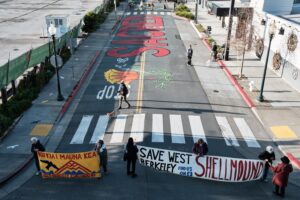The photos were like huge portals into forests all over California, ready to be entered if a spell allowed it. On one wall, you could step into a six-foot-tall image of a tangle of manzanitas, shiny and ochre-red, at Henry W. Coe State Park. On another, you could surround yourself in a spring-green fairyscape at a Briones Regional Park oak woodland. Near it was a grove of sequoias, outbeefing all other living things. Occasionally a figure, like a deer or the photographer himself, popped up in the midground like a two-inch Waldo, confronting the viewer with the enormity of the scene. But most photos had no central subject—no hero tree. “He’s not telling you where to look,” said Leslie Howard, a friend who accompanied photographer Stefan Thuilot, a Berkeley-based landscape architect, on some of his forest trips. He is giving you a way in.

At UC Berkeley’s Wurster Gallery last fall, surrounded by Thuilot’s giant photographs (up to 13 feet long), the crowd seemed quieter than the usual wine-loosened art scene. But not Stu Winchester, who pointed to a weenie of a conifer poking up amid some giants in Sequoia National Park. “Here are these stupid white firs. They pop up in the shade, grow so easily,” he said. “I’m so mad I could spit.” Winchester teaches ecology at Merritt College. The next photo over was from the same spot, after the kind of fire that could kill sequoias. Somehow the weenie white fir had survived. A scientist might ask why. The photo would serve, Thuilot hoped, as data. But it could not help being art, too.
See giant forest photos
Stefan Thuilot’s California Forest Project will be on display starting May 30, 2024, at the David Brower Center’s Hazel Wolf Gallery, at 2150 Allston Way in Berkeley. The exhibit opening is 6:30pm–8:30pm on May 30; it’s free with reservation recommended.


Thuilot has photographed some 800 scenes like this across the state, in what he has dubbed the California Forest Project, and is still trucking along. The seed of the project was planted when Thuilot was taking a class with the UC Berkeley forest ecologist Joe McBride, who expressed frustration at the lack of a decent set of photographs depicting all the types of California forests. Mind you, there are a lot. Twenty percent of the state is forested. California has the biggest trees (sequoias), the oldest ones (bristlecone pines), and arguably some of the weirdest ones (Joshua trees). Innocently, Thuilot set out to photograph all forty-odd forest types and make himself useful. That was in 2017.
Forests are ridiculously hard to photograph. There’s always some tree in the way, and greens that are even a little bit off can look terribly wrong. But Thuilot likes a technical challenge, and he isn’t afraid to go big. The photographs’ locations are burned in his head, often because they were so hard to get to. At Calaveras Big Trees National Park’s south grove, which has not seen fire for 130 years, it was like mountaineering getting through the undergrowth, with chasms yawning amid piles of branches. Thuilot once fell seven feet into such a gap. All this effort impressed McBride, who had, in his classes, long used photos that he had taken from roadsides. “I should have followed his lead and gotten in there!” he said.

At each forest spot, Thuilot systematically shot a grid of 18–24 photographs by making precise adjustments to his tripod. Later, he stitched them together; making one image may take a day. The resulting images contained an extraordinary amount of information, and Thuilot brought his landscape architect’s precision to the printing, which he did himself. He was inspired by 19th-century landscapes, where the painters tried to fit everything into a single huge scene.
McBride told me, “I see so much more in his photographs than I see in Ansel Adams’ photographs of the redwoods.” Where Adams used shadows for drama, Thuilot sought out overcast days to maximize the detail in the flora. In a century, someone could come back and shoot Thuilot’s scenes on another cloudy day, and learn what had changed. You can laser-scan the forests from aircraft and get images that are more immediately quantifiable. But Thuilot’s photos can show forests’ interior structure, from the understory up—and “they are much more readable,” McBride says.
The photographs turned out to be useful a lot sooner than Thuilot expected, as California’s forests began to burn. Sometime in the past decade, they began changing on the scale of days instead of decades. Thuilot was among the first to re-enter Sequoia National Park after it burned in 2017, setting out for the spot he had photographed earlier. Seeing it charred, he surprised himself: he was in tears. “These trees have so much to say. They’re so big and ancient.” But he also realized he could do some useful repeat photography himself, instead of leaving it for the next generation. Now Thuilot is working with fire ecologists to document Sierra forests before and after controlled burns. “Those photos could document the change created by the prescribed fire in the grove,” wrote UC Berkeley professor Scott Stephens, in a terse mid-fire-season email. They “could complement field data taken from the same area.”

At the gallery, McBride stood in front of the Sequoia National Park before/after. His ecologist brain was busy decoding their “hundred little messages.” The fire had been very hot. “What caused these trees to burn up so high, when there’s no fuel under them? What allowed this one to survive?” (He meant the weenie white fir.) Another photo, from the Russian Wilderness up near the Oregon border, showed eight different kinds of conifers. “To my knowledge, this is the only photo that captures that many tree species,” McBride said. A rare place, where such different ranges overlapped. Firewise, though, it looked like “trouble in the long run,” dense with greenery close to the ground. McBride, now an emeritus professor, had seen our current problems coming a long way off and had tried to warn people about it. “A lot of us predicted the fire era,” he said, modestly.
“What I see is something really powerful,” gallery visitor Bill Anelli said, with a thump to his chest. “Stirring and beautiful.” Anelli, who teaches environmental ethics at Modesto’s community college, wished his college could house a chapel of such photographs for his students to sit with and decide, sans instruction, what they thought about them. Many of them had never visited forests outside the Central Valley, he said. “You’ve heard of No Child Left Inside? All of that.” It’s true, redwoods have been scientifically documented to have a kind of chapel effect. McBride said he once took decibel meters into Muir Woods, and found that people quieted down measurably when they got into Cathedral Grove, even without any signage or humans to hush them. At least two other gallery-goers suggested that Thuilot’s photos should be printed on billboards or tall buildings. If you can’t go see the forest, maybe the forest can come to you.







